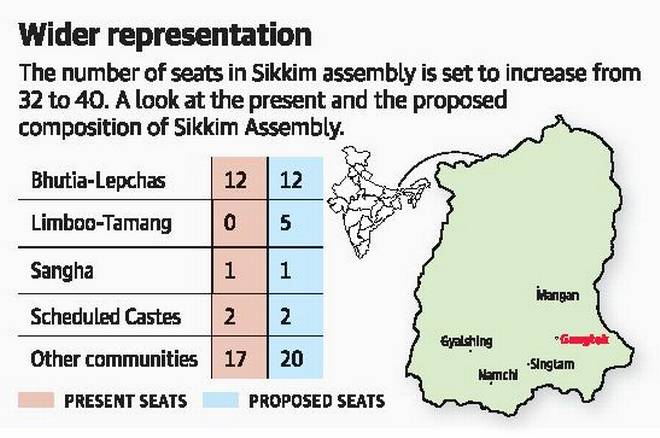Context:
- The Home Ministry has moved the Union Cabinet to increase the number of seats in the Sikkim Assembly from 32 to 40.
- The Cabinet Committee on Political Affairs, headed by Prime Minister Narendra Modi, will soon decide on the proposal.
Background
- A petition was moved in the Supreme Court that Limboos and Tamangs were not adequately represented in the Assembly, and the court in 2016 directed the Home Ministry to take action.
- The tribal community nursed a sense of deprivation of their political and fundamental rights, ever since they had been declared a Scheduled Tribe in 2003 under Article 342 of the Constitution.
- There are 90,000 Limboo-Tamangs.
- By the Delimitation Act, 2002, the number of seats in an Assembly can be readjusted only on the basis of the first census after 2026.
- The Second Schedule to the Representation of People Act, 1950 and Section 5A of the Representation of People Act, 1951 have been amended to change the Assembly strength.

Bhutias-Lepchas
- Sikkim has 12 seats reserved for Bhutias-Lepchas.
- It is not because they are a Scheduled Tribe, but as a sequel to a political agreement in 1973 between the Government of India, the former Chogyal (King) of Sikkim and political parties.
Significance
- The seats are being increased to accommodate the Limboo and Tamang communities, notified as Scheduled Tribes in January 2003.
- Of the eight new seats, five will be reserved for them.
- If approved, it will be the first expansion of the Assembly since Sikkim merged with India in 1975.
Limbu
- They are Kirati people indigenous and native to their homeland himalayas, hills, mountainous and plains regions.
Tamang people
- Tibeto-Burman ethnic group
Bhutias
- They are a community of people of Tibetan ancestry, who speak Lhopo or Sikkimese, a Tibetan dialect.
- The Bhutias are spread out over Nepal, Bhutan, and in northern West Bengal, especially in the towns of Kalimpong and Darjeeling.
- The Bhutias as recognized as Scheduled Tribes in the states of Sikkim, West Bengal and Tripura.
Lepchas
- They are among the indigenous peoples of Sikkim.